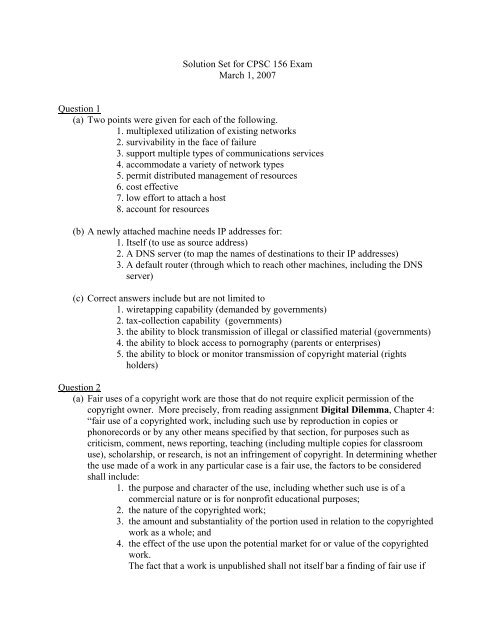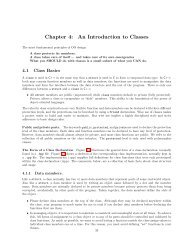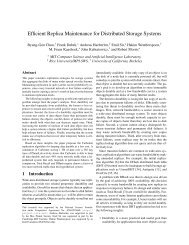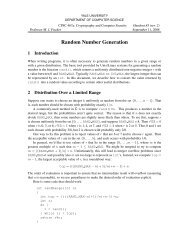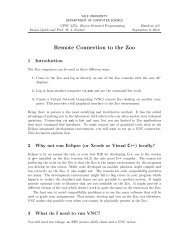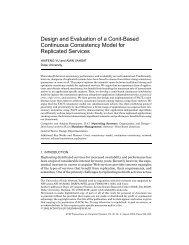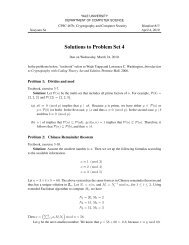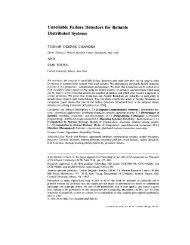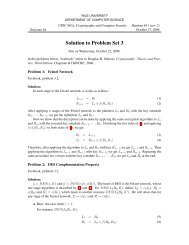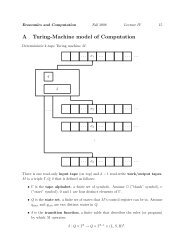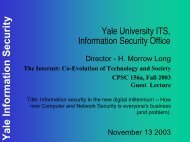Answer Key - Zoo
Answer Key - Zoo
Answer Key - Zoo
You also want an ePaper? Increase the reach of your titles
YUMPU automatically turns print PDFs into web optimized ePapers that Google loves.
Solution Set for CPSC 156 ExamMarch 1, 2007Question 1(a) Two points were given for each of the following.1. multiplexed utilization of existing networks2. survivability in the face of failure3. support multiple types of communications services4. accommodate a variety of network types5. permit distributed management of resources6. cost effective7. low effort to attach a host8. account for resources(b) A newly attached machine needs IP addresses for:1. Itself (to use as source address)2. A DNS server (to map the names of destinations to their IP addresses)3. A default router (through which to reach other machines, including the DNSserver)(c) Correct answers include but are not limited to1. wiretapping capability (demanded by governments)2. tax-collection capability (governments)3. the ability to block transmission of illegal or classified material (governments)4. the ability to block access to pornography (parents or enterprises)5. the ability to block or monitor transmission of copyright material (rightsholders)Question 2(a) Fair uses of a copyright work are those that do not require explicit permission of thecopyright owner. More precisely, from reading assignment Digital Dilemma, Chapter 4:“fair use of a copyrighted work, including such use by reproduction in copies orphonorecords or by any other means specified by that section, for purposes such ascriticism, comment, news reporting, teaching (including multiple copies for classroomuse), scholarship, or research, is not an infringement of copyright. In determining whetherthe use made of a work in any particular case is a fair use, the factors to be consideredshall include:1. the purpose and character of the use, including whether such use is of acommercial nature or is for nonprofit educational purposes;2. the nature of the copyrighted work;3. the amount and substantiality of the portion used in relation to the copyrightedwork as a whole; and4. the effect of the use upon the potential market for or value of the copyrightedwork.The fact that a work is unpublished shall not itself bar a finding of fair use if
such finding is made upon consideration of all the above factors.”(b) Correct answers (worth two points each) include but are not limited to:1. Digital copies are perfect.2. Digital copies can be made at zero cost.3. Digital copying is not necessarily a good proxy for infringement.4. A perfect TPS could moot fair use: no infringement, no charge, no fair-usedefense.5. No TPS can be perfect in today’s computers. General purpose PCs areprogrammable, and hence TPSs are circumventable (at least by experts).(c) In his February 6, 2007 essay “Thoughts on Music,” Jobs says that Apple has thus farNeeded to use DRM in its iTunes system, because major-label record companies, whichown the copyrights on most widely distributed popular music, refused to enter into alicensing agreement without it. (Perhaps Apple was also hoping that the FairPlay DRMsystem would lock consumers into iTunes by erecting a [low] barrier to the movement ofsongs to other digital-music players, but you need not have included this point in youranswer for full credit.) Jobs goes on to say that, because DRM has failed to preventpiracy or to force people to buy music, and DRM annoys consumers, digital-musicdistributors should do away with it. His conclusion that DRM has failed to force peopleto buy music is based on the observation that, of the 22 billion songs purchased last year,20 billion were sold DRM-free on CDs, while only 2 billion were sold online in DRMprotectedformats.Question 3(a) Disintermediation is the shrinkage of the retail chain that occurs when web-basedcommunication is used to bypass one or more of the intermediaries that traditionallyoperated between manufacturers and consumers.(b) Reintermediation occurs when a new type of intermediary inserts itself into the retailchain, providing value to consumers, manufacturers, distributors, and/or other parties in amanner that would not be possible without the Internet and the web.(c) Multichannel retailers are those that communicate with their customers (for sales,marketing, etc.) through multiple channels, e.g., through some combination of websites,brick-and-mortar stores, printed catalogs, television, and telephone. Advantages enjoyedby multichannel retailers include opportunities to leverage offline brands, to use profitsfrom offline channels to subsidize e-tail start-up (rather than relying on venturecapitalists), to use established distribution and fulfillment infrastructure, and to mine dataon existing customers.(d) It is hard for a typical C2C seller to do market research and set an optimal fixed price.Auctions allow such sellers to increase revenue by requiring potential buyers to declarehow much they are willing to pay.
Question 4(a) Analysis of the contents of web pages and of the link structure of the WWW digraph.(b) The crawler traverses the entire web to find new, updated, and removed pages. PageRankis a linear-algebraic algorithm that calculates the importance of a webpage; it uses thelink structure of the WWW digraph and, in particular, interprets a link from page A topage B as a “vote” by A for B.(c) 65% of books are in copyright and out of print; libraries are basically the only places inwhich most people can get access to these books. This fact is indeed relevant to thequestion of whether Google’s proposed project is fair use. For example, one of the fourfactors that go into determining whether something is fair use is the effect that the usewill have on the market for the copyright work. By letting a work go out of print, thepublisher has ensured that there is no market for new copies of this work. Thus, byproviding search technology that makes it easier to locate these books, Google could notdestroy the (nonexistent) market for them; it might, in fact, create a market for some ofthem, in response to which publishers could reprint them and make a profit. (Otherarguments could be made for the relevance of the fact that 65% of books are in copyrightand out of print; full credit will be given for any sound argument.)(d) The database of scanned books could be hacked; digital copies of books could then bedistributed by pirates.Question 5(a) A product exhibits network effects if its value to any single user is strongly positivelycorrelated with the total number of users. It exhibits lock-in and high switching costs ifthe cost of discarding it for a competing product is greater than the sticker price of thenew product (because of, e.g., technical difficulties of switching or reliance on the rest ofthe user community). Information and communication technologies (ICTs) very oftenexhibit network effects. ICT industries often involve systems of interoperatingcomponents and durable complementary assets. Prime examples are Intel processors, theWindows PC Platform, and numerous PC application programs. Users become locked inand experience high switching costs, because it is much more difficult and costly todiscard an entire system of interoperating components than it is to discard one product.Moreover, individual decisions to switch can be futile if most users of the system ofinteroperating ICT components do not switch.(b) eBay is not just a network-effected technology. It is also a massive community of people.Network effects fueled rapid, widespread adoption of the Netscape browser, but in fact itwas WWW browsing in general that ultimately benefited from those effects; the valuethat one person derives from access to a browser depends on the number of other peoplewho have access to browsers (because more good web pages will be posted if morepeople can view them) but not on which particular browser(s) are in use. This is not trueof auction sites: For an online buyer or seller to benefit from growth in the size of theC2C-commerce community, the particular site(s) that he or she uses must experience this
growth.(c) A company can profit from providing one product for free and selling a complementaryproduct. For example, viewers for Microsoft WORD and PowerPoint files are availablefor free, but Microsoft sells the programs one needs to create or modify WORD andPowerPoint files. Similarly, viewers for PDF files are available for free, but Adobe sellsthe program needed to create or modify PDF files. A company could also profit fromgiving away an information product and selling support or training services; this is RedHat’s business model.Question 6(a) Physical Layer EthernetIP Layer RoutingTransport Layer Congestion controlApplication Layer Email(b)blueredyellow(c) This scenario is given in http://zoo.cs.yale.edu/classes/cs155/fall01/cranor.ppt and waspresented in class on February 6, 2007: Suppose that the same online-advertisingcompany displays ads on a health-information site and on a bookstore site. If you clickon one of the ad company’s ads while using the health-information site, the ad companymay store a cookie on your computer that includes information about the medicalconditions you looked up. If you later click on one of the same ad company’s ads whileusing the bookstore site, that cookie could be retrieved and the information stored in itused in an interaction between the ad company and the bookstore site. Full credit wasgiven for any technically accurate answer, not just the ad-company scenario. Note,however, that (1) cookies are only sent back to the site that set them (as stated inhttp://zoo.cs.yale.edu/classes/cs155/fall01/cranor.ppt and presented in class on February6, 2007), and (2) cookies are data records, not programs; they do not send anythinganywhere.(d)1. False2. False. (If you’ve visited this site before, your machine may have cached theaddress.)3. True4. False. (This task is centrally managed by ICANN.)


